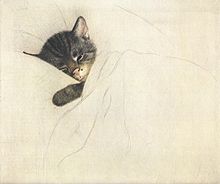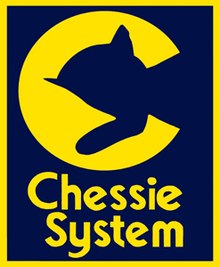Chessie (mascot)
Chessie is the name of an advertising mascot for the US railroad company Chesapeake and Ohio Railway . The drawing of a sleeping cat was the most famous advertising symbol and trademark of this society. Later, an abstract of this drawing became the trademark of Chessie System Inc.
origin
The Austrian artist Guido Grünewald (1881–1935) created many etchings of animals, especially cats. Some of his works were sold to the Robertson-Deschamps gallery in New York . This also included the depiction of a sleeping kitten.
Chessie as the symbol and trademark of the Chesapeake and Ohio Railway
In 1932 the Chesapeake and Ohio Railway put the fully air-conditioned George Washington express train from New York City to St. Louis into service. In cooperation with the advertising agency Campbell-Ewald, Lionel C. Probert, head of marketing at Deutsche Bahn, developed the advertising campaign for it. After more air-conditioned express trains ( The Sportsman and The Fast Flying Virginian ) were to be put into service in 1933 , an expansion of the campaign was planned. While rummaging through the Herald Tribune , Probert saw the drawing "Sleeping Cat" by Grünewald. He came up with the slogan “Sleep like a kitten” (“Sleep like a kitten”) instead of “Sleep like a top” (“Sleep like a marmot”, literally: “Like a top”).
In the September 1933 issue of Fortune , the first ad with the sleeping kitten and the slogan "Sleep like a kitten" appeared, promoting the express trains. In December 1933 the railway company acquired extensive rights of use for the picture from the Robertson-Deschamps gallery. The drawing first appeared on the timetable for the passenger trains on December 17, 1933. Until the suspension of passenger services on the Chesapeake and Ohio Railway on April 30, 1971, the drawing was printed on most of the company's timetables. It also graced the Society's calendar for 1934, which had an edition of 40,000.
Further advertisements appeared from March 1934 in the company magazine of C&O The Rail . On January 1, 1935, the advertisement "Acknowledgment to Chessie" appeared. This was the first time the cat was called "Chessie". The ad also featured two scaled down images of the cat. This motif was called "Chessie and the kittens". The 1935 edition of the C&O calendar also featured this motif. Since 1935 marked the 100th anniversary of the railway company, the Chessie motif was only used sporadically in the advertising campaigns.
In 1936 the first complete Chessie campaign was started. Various advertising motifs were also published which, in one form or another, linked Chessie with the railway company or its offers. In addition, a card game with the Chessie motif appeared for the first time. The following year the campaign was expanded further. There was also another cat motif. With the seated “Peake” the father figure was introduced and the cat family was completed. The introduction took place appropriately in the context of an advertisement for Father's Day . With the publication of Ruth Carroll 's children's book "Chessie and Her Kittens", the mascot's popularity rose even further outside of the Chesapeake & Ohio catchment area.
From 1938 the Chessie campaign was continued in a reduced form. Advertisements were limited to the company magazine and selected advertisements in national magazines. The success of the entire campaign was reflected in the steadily increasing demand for the railway company's annual calendar with the Chessie motif and an increasing number of fan mail. The success of the campaign also went hand in hand with greater use of C & O's long-distance trains.
With the entry of the United States into World War II in 1941, the statements made in the advertisements also changed. The cat Peake was portrayed in an army uniform. There were also advertisements with Chessie for the subscription of war bonds and civil defense . From 1942 advertisements appeared with the slogan "Geared to the War Go of America", which represented individual aspects of rail traffic and were always provided with the Chessie drawing. The calendar for 1943 was adorned with a drawing in which Chessie was lying under the bed in a sleeping compartment, clearing the bed for a member of the military. The world war was thematized up to the 1946 calendar.
After the end of the war, the railway company began under the direction of Chairman Robert R. Young with an extensive investment program that did not stop at individual experiments. From 1946 the PR department was headed by Thomas J. Deegan Jr. In 1946 the luxury train "The Chessie" was to be introduced. This train was supposed to be pulled by the steam turbine locomotives of the class M-1 . This was also the motif of the 1947 calendar, which appeared in an edition of 250,000 pieces. In January 1947, an exhibition of Chessie drawings and the backstory was held at the Terminal Tower in Cleveland . The calendar for 1948 once again focused on the luxury train “The Chessie”. The print run was 425,000 and, on the occasion of the 15th calendar with the Chessie motif, contained a brochure that showed all previous motifs and provided background information. Financial difficulties of the railway company and the drastic decline in passenger traffic meant that the introduction of the luxury train was abandoned, and most of the newly acquired passenger cars were sold by 1951.
Faced with this situation, the PR department began to expand the merchandising with the Chessie motif. First, scarves and children's sleepwear were offered. The program was expanded until the mid-1970s and finally included a wide variety of popular marketing articles. During the Chicago Rail Fair 1948/1949, Chesapeake & Ohio served their guests in a dining car called "The Chessie Club". From 1954 a sleeping / buffet / lounge car (no. 1903) ran under the same name on the long-distance train "The George Washington".
In the passenger trains, more and more parts of the equipment were provided with the Chessie motif. "The Chessie Route" was also always mentioned in the advertisements. This eventually led to Chessie becoming synonymous with the railway company. The company magazine was renamed "Chessie News" in 1958. Even in the 1950s, Chessie was the theme on society's calendars throughout. During this time, Chessie was mostly portrayed with a child. The calendars for 1955, 1957 and 1958 did not deal with passenger traffic. The circulation was around 250,000 copies.
In 1957, the railway company experimented with marking with the Chessie motif on six different freight cars. However, this idea could not prevail.
The decline in passenger traffic continued into the 1960s. After all, from 1968 onwards, “The George Washington” was only operated as a single passenger train. This change was also reflected in the fact that the advertising slogan “Sleep like a kitten” was used less and less. Because of the well-known mascot, the merchandising products became a sales success for the railway company, although many of the buyers had never ridden a passenger train and did not know the story behind the mascot. The drawing and the Chessie claim were also used from 1965 on by the Baltimore and Ohio Railroad, which is controlled by the C&O . Even after Amtrak took over passenger transport in 1971 , Chessie was used to advertise ferry operations on Lake Michigan .
In 1973 the last calendar for the time being appeared with Chessie as a trademark. In 1978, however, the tradition was resumed. Several other cat drawings by Guido Grünewald were shown in this calendar. The printing of annual calendars with the Chessie motif was later continued under the successor company CSX Transportation . Today the Chesapeake and Ohio Historical Society operates the merchandising distribution of Chessie products and also publishes an annual calendar.
Chessie as a trademark of Chessie System Inc.
In 1963, the Chesapeake and Ohio Railway took over the Baltimore and Ohio Railroad. However, the two railway companies still retained their independence. In order to be able to survive better in the competition with the competitor Norfolk and Western Railway , a merger was considered. In a 1965 study, it was suggested that Chessie be used as the common company name. The reasons given were, among other things, the great popularity, the symbolism for careful transport, the great difference to the license plates of other railway companies and the strong identification with the C&O. The drawing should also be continued as the new company logo. Since closer cooperation was not possible due to an agreement with the Interstate Commerce Commission , these proposals were not pursued further.
In 1972 people began to think again about a joint market presence for the railway companies. The author of the 1965 study Howard Skidmore, now vice president of public relations and advertising at C & O / B & O, suggested using Chessie System as the corporate name. In cooperation with Franklyn Carr (C&O design chief) he developed the new Ches-C logo from the well-known Chessie motif and the letter C.
For the color scheme of the locomotives and wagons presented in 1972, a very conspicuous yellow-red-dark blue color scheme was chosen. In 1973, Chessie System Inc. was finally founded as the joint parent company.
The logo and color scheme were used until 1986 and replaced with the merger to form CSX Transportation .
literature
- Thomas W. Dixon Jr .: Chessie, The Railroad Kitten . 10th edition. TLC Publishing Inc., Lynchburg (Virginia) 1999, ISBN 0-9622003-1-X (American English).
Web links
Individual evidence
- ^ Dixon Jr., Chessie, The Railroad Kitten, p. 52


